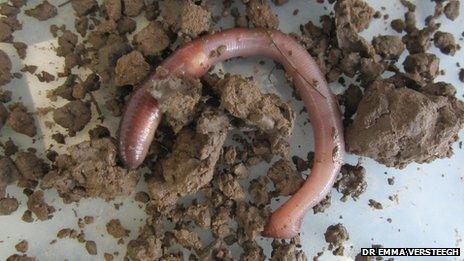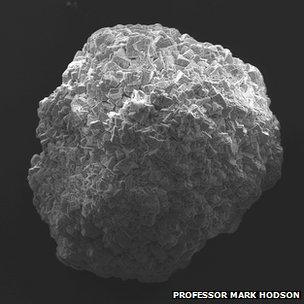Worm poo's window into past climate
- Published

The worm secretions may act as a "self-produced indigestion tablet"
Earthworm faeces can be used to measure past temperatures, providing a window into the ancient climate.
A study shows that the chemistry of small balls of chalky crystals secreted into soil by the worms varies with temperature.
A UK team said the granules could be compared with other climatic "proxies", such as ice cores and deep sea sediments.
Details appear in the journal Geochimica et Cosmochimica Acta, external.
Scientists from the universities of Reading and York report that the calcium carbonate (calcite) nodules dug up from archaeological sites give a unique measure of the ancient local temperatures.
Because the ratios of different isotopes, or forms, of oxygen within the calcite crystals vary with temperature, they record the conditions present as they grow inside the worms.
The granules are up to 2mm in size and have a distinctive appearance, so can be identified in the soil at archaeological sites.
New balls
Emma Versteegh, lead author on the paper, commented: "Earthworms secrete several each day, so they provide a record of the seasonal variations in temperature as well as local geographical variations."

The calcite balls were spotted by Charles Darwin in 1881
The team is focussing on samples dating back thousands of years and have recovered them from Silbury Hill, a neolithic burial mound near Stonehenge in the UK.
Their approach will provide a picture of local climate variations at such sites over thousands or even hundreds of thousands of years.
Charles Darwin discussed the remarkable chalky balls that earthworms secrete in 1881, in his final work The formation of vegetable mould, through the action of worms, with observations on their habits, external.
The nodules form in a pale gland visible on the underside of an earthworm, about seven segments down from the head.
Darwin suggested that earthworms might use the granules to neutralise acid in their gut, and more recent experiments suggest that he was right.
Prof Mark Hodson, lead investigator of the current project, describes the granules as "a self-produced indigestion tablet".
Other geochemical measurements of past temperature and climate can be compared with the earthworm granule method, such as ice cores, deep-sea sediments, and tree rings.
But the latest approach provides a record that is sensitive to variations in time, as well as being geographically specific, giving a route to measuring local temperature and weather conditions in the ancient past.